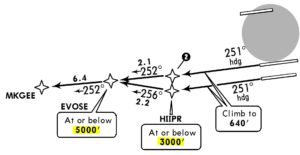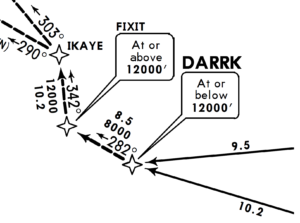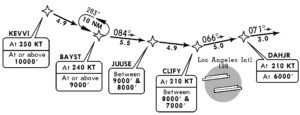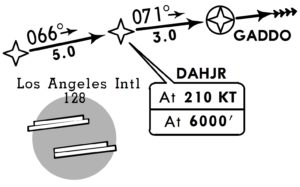Early last year, the FAA revised the SIDs and STARs at Los Angeles KLAX airport. I don’t know if I had annual leave or missed any associated documentation, but it’s fair to say that as a fleet that basically operates into the East Coast of Australia and LAX exclusively – it was something of a baptism of fire. There are a number of issues that subsequently developed, and we’re actually grappling with the best way to deal with some of the issues that resulted, even today. Let’s head down the rabbit hole.
Let’s start with a look at two of the typical procedures introduced – the DARRK Standard Instrument Departure (SID) and the RYDER Standard Terminal Arrival (STAR). The following features are worth pointing out for further discussion :
Note : As always, the reproduction of charts, procedures, text, images, etc is absolutely not for operational use or for any commercial gain. Please use this information as the genesis of thought to determine how you and your training/standards department might need to adapt to the issues discussed.
DARRK-ONE (Link)
 There’s a 3000B (3,000 ft or Below) restriction off the end of the runway. It’s rare that a long haul jet will ever be limited by this restriction. Procedurally, this should be set in the MCP Altitude Selector to ensure compliance; in practice, this is not done and instead, the following 5000B restriction is set. For the purposes of workload management, this makes sense – it’s one less (uncessary) thing to have to do (reset it to 5ooo) during the high workload, low to the ground phase that is shortly after takeoff. But this practice is a normalised deviation that must be briefed by the crew before departure. Again, in practice, we’re always using VNAV for departure so the 3000B restriction is protected by the FMC even if the MCP Altitude Selector is not set. Where this gets us into trouble is when you’re in the sim at lighter weights.
There’s a 3000B (3,000 ft or Below) restriction off the end of the runway. It’s rare that a long haul jet will ever be limited by this restriction. Procedurally, this should be set in the MCP Altitude Selector to ensure compliance; in practice, this is not done and instead, the following 5000B restriction is set. For the purposes of workload management, this makes sense – it’s one less (uncessary) thing to have to do (reset it to 5ooo) during the high workload, low to the ground phase that is shortly after takeoff. But this practice is a normalised deviation that must be briefed by the crew before departure. Again, in practice, we’re always using VNAV for departure so the 3000B restriction is protected by the FMC even if the MCP Altitude Selector is not set. Where this gets us into trouble is when you’re in the sim at lighter weights.
Remember that our SOPs should cater for most if not all of our operating range – not just what we see most days on our limited route network …
. There’s a particularly insidious trap associated with the 12000B (12,000 ft or below) and 12000A (12,000 ft or above) paired restrictions at the DARRK / FIXIT waypoints. As it turns out, for a heavyweight departure in typical conditions, combined with acceleration at 10,000 ft from 250+ KIAS to normal climb speed after departure – we can’t make the 12000A restriction at FIXIT. While eventually these traps become known from experience, often it takes a while to find them. Predicting climb performance is not one of the better skills of the FMC; and it’s actually rare for us to depart this way out of DARRK – usually we’re routed in a more southerly manner. In any case, you would expect that well before you get to FIXIT, the FMC will work out you can’t make it and let you know that you are UNABLE NEXT ALTITUDE, typically in time for you to either fix it or give ATC sufficient notice to ensure they can let you out of the restriction … .
There’s a particularly insidious trap associated with the 12000B (12,000 ft or below) and 12000A (12,000 ft or above) paired restrictions at the DARRK / FIXIT waypoints. As it turns out, for a heavyweight departure in typical conditions, combined with acceleration at 10,000 ft from 250+ KIAS to normal climb speed after departure – we can’t make the 12000A restriction at FIXIT. While eventually these traps become known from experience, often it takes a while to find them. Predicting climb performance is not one of the better skills of the FMC; and it’s actually rare for us to depart this way out of DARRK – usually we’re routed in a more southerly manner. In any case, you would expect that well before you get to FIXIT, the FMC will work out you can’t make it and let you know that you are UNABLE NEXT ALTITUDE, typically in time for you to either fix it or give ATC sufficient notice to ensure they can let you out of the restriction … .
…except that in this regard, the FMC only looks one restriction ahead, and in this case most of the way the FMC is saying to itself “Yep, I can make 12000B at DARRK, no problem … Yep, I can make 12000B at DARRK, no problem … Yep,I can …” right up until the DARRK waypoint is passed at which point the FMC says “Frack … we aren’t going to make 12000A at FIXIT! – Tell ’em UNABLE NEXT ALTITUDE” – which finally takes place with about 6 miles to go to FIXIT. Embarrassing. The solution is to pick up on this a little early and use MCP Speed Intervention to delay climb speed acceleration until you’re assured of 12000A at FIXIT. Or tell ATC in advance.
.- Finally, with the introduction of these procedures, ATC are using some pretty weird phraseology, particularly in respect of altitude clearances, which once again took me by surprise at the time; but now are at least commonly understood now that we’ve found some documentation on them. More reading here, and here.
Moving on … the issues above aside, the real excitement that has come from these procedures is in the STARS. Much like the old adage where “Takeoff is easy – that’s just Brute Force over Ignorance – it’s Landing where real piloting skill comes in ...” – the new arrival procedures have presented the most opportunity for workload and stress into the calm, collected, highly procedural arrival experience that has always been a morning arrival into KLAX …
RYDER-ONE (Link)
There are several challenges with STARs like this, only further complicated by the inevitable ATC speed/altitude/heading interference and radio workload that comes with any arrival into one of the highest traffic density airports in the world. And speaking of ATC …
While mentioned before, the arrival phase and ATC Altitude Clearance procedures really presented the change to status quo and a few challenges. Prior to this, a typical STAR and Descent clearance into pretty much any airport in the world left no doubt as to what altitude you were descending to. Now with the introduction of “Descend Via the (XXX) Arrival” and the regular interjection of “Except Maintain … ” – we’re now looking at the chart to find out what the eventual stop altitude is (6000 ft for the RYDER) as well as what the next restriction was on the chart, and how to remember a clearance altitude we can’t set into the MCP Altitude Selector.
I’ve spoken to crew who operate into LAX regulary who review the FAQ each time – I can certainly understand why and suggest this is a pretty good defence measure against this (relatively) new and potentially confusing phraseology and it’s implications.
But moving on the STAR specifically …
 In terms of Altitude restrictions, there are LOTS of them. The RYDER STAR comes with no less than 11 altitude requirements, along with 5 speed requirements. It’s not a simple STAR. Accompanying that is the fact that 6 of the waypoints that include single and multiple altitude/speed requirements are in some cases less than 5nm apart – and you’ve got a busy time ahead of you.
In terms of Altitude restrictions, there are LOTS of them. The RYDER STAR comes with no less than 11 altitude requirements, along with 5 speed requirements. It’s not a simple STAR. Accompanying that is the fact that 6 of the waypoints that include single and multiple altitude/speed requirements are in some cases less than 5nm apart – and you’ve got a busy time ahead of you.- The inclusion of so many altitude restrictions so close together brings into play the possibility of the Alternate MCP Altitude Setting technique (see below). In essence however, it’s only of minor use in this area, and only for part of the STAR.
- While the Aircraft is fully capable of flying this STAR beautifully from beginning to end with little intervention required from the pilot – the Real World has something else to say about it. Speed intervention from ATC takes us out of the all singing-and-dancing VNAV PTH mode where our compliance confidence could be high, into VNAV SPD where more monitoring and back of the brain crosschecking is required. For sure, the requirement to continually set and re-set the MCP Altitude Selector on the way down maintains a high level of workload as well.
- Meanwhile, ATC commonly requires you to maintain an additional altitude restriction over and above the end of the STAR (“Descend via the RYDER-ONE Arrival, Except Maintain 9,000 feet.“). This is another aspect of the not having your cleared altitude in the MCP Altitude Setter (see below).
- After all that, it’s not unusual to be taken completely off the STAR (Heading, Altitude and/or Speed) for a while to provide traffic separation (or short cut you in) before being told to rejoin the STAR again for Tracking, Altitude and Speed purposes in the usual (I find) confusing instruction set hitherto mentioned.
What remains below are small treatises on the three issues that have come up for discussion as a result of these procedures. I believe what is written below is firmly rooted in Boeing Documentation and Boeing Philosophy – your view may vary … In the end changes, published procedures, and ATC actions increase our workload and make our job of maintaining a safe flight environment just that little bit harder- but hey, if you can’t take a joke, you shouldn’t be playing the game, should you?
At-Or-Below Altitude Restrictions on Descent and MCP Altitude Setting
As a side-bar, there is presently a discussion over whether we should be setting At-Or-Below altitude restrictions in the MCP Altitude Setter during descent. A similar discussion can be had in terms of setting At-Or-Above altitude restrictions on climb.
The Boeing FCTM seems clear on this point – as an over-arching principle, we should set all altitude constraints to ensure awareness and compliance. For sure when you’re not in VNAV – you must set them all, including (by implicaton) the At-Or-Below’s. But FCTM 4.19 specifies in particular [“Restrictions” or “At or Above” constraints] and (I believe) intentionally leaves out At-Or-Below’s. I believe this means we can leave them out (in VNAV), and that seems to be common practice anywhere I’ve operated. But I suggest you consider this (sort of) a normalised deviation, and brief that sucker.
While setting the At-Or-Below’s may increase situational awareness, it achieves nothing practical in terms of protecting compliance with the restriction and in fact increases the likelihood of an unwanted VNAV ALT capture during the descent.
So – if we don’t set them, what’s the risk? The risk is we don’t make the restriction and because it’s not on the MCP Altitude Selector and on PFD in front of us – we forget to monitor. The protection available at this point falls into the Climb and Descent scenarios:
- Climb : Anytime VNAV is unable to meet the next climb constraint altitude, the FMC scratchpad message UNABLE NEXT ALTITUDE is displayed.
- Descent : Essentially, there is no alerting/protection available for an At-Or-Below descent constraint when out of VNAV PTH. If you’re in VNAV PTH, the FMC will accelerate the aircraft in order to maintain the path – up to a certain point, then annunciate DRAG REQUIRED. If things continue to worsen, eventually the AFDS reverts to VNAV SPD and all but abandons the attempt to meet the constraint – your turn. But if you’re in VNAV SPD to begin with – it’s all up to you and there’s no alerting to highlight that you’re not going to meet the descent requirement.
As always – if you have a restriction in the FMC between you and your MCP Altitude Selector, a single press of the selector will clear that restriction – and this includes the At-Or-Below altitudes you aren’t setting. This is the REAL risk of not setting at-or-below’s and why every single un-necessary press of the altitude selector in the aircraft (or simulator) is subject to a one beer penalty after the flight.
Alternate MCP Altitude Setting Technique
The Alternate MCP Altitude Setting Technique is an FCTM documented get-out for setting all the altitude restrictions on a SID or STAR (or Approach) where altitude restrictions are so “closely spaced” that “crew workload is adversely affected” and “unwanted level-offs are a concern.”
It must be clearly stated at the outset that this is not a technique that supports setting the End-Of-STAR altitude when initially cleared for Descent via the Arrival as has been suggested in some quarters. There is, in fact, no justification for such a non-standard, anti-Boeing philosophy technique anywhere in the FCTM, except perhaps for Tailored Arrivals (TA) – which these procedures are not.
For sections of a STAR where the waypoints and altitude constraints are closely spaced, the Alternate MCP Altitude Setting technique is a possibility, and in such cases the PF typically sets the lowest constraint, while emphasising the hell out of the fact that intervening MCP altitude protection is not available, and that a single inopportune press of the MCP Altitude Selector will delete the next FMC altitude protection, without confirmation and possibly without notification to the pilot. For this reason (and others) Boeing specifies that an operator must provide specific training to crew on this technique, including:
- The specific terminal procedures to which this technique can be applied (and by implication, which sections of the procedure)
- Highlighting the risk of altitude violations and the risk of FMC restriction loss through MCP Altitude Intervention
Until your training organisation has provided this training, and promulgated the procedures to which it applies, the Alternate MCP Altitude Setting technique should not be employed. Note that any training you may have received on not setting altitude during an NPA is unlikely to extend to the use of this technique during SIDs and STARs – but your mileage may vary.
Cleared to an Altitude NOT set in the MCP Altitude Selector
Quite typical with these procedures, is a separate requirement to finally meet an altitude requirement that is either at the end of the SID/STAR – or required by ATC in addition to those promulgated in the chart. Typically this consists of clearances such as …
- Velocity One, Descend via the RYDER ONE Arrival; or
- Velocity One, Descent via the RYDER ONE Arrival, Except Maintain 9000.
In both cases, the first altitude to be set in the MCP Altitude Selector is … FL200 (for the arrival from ELKEY via EESSA). After that, you’ll be setting 14000, then 11,000, then 10,000, then 9000, then (if cleared in the second instance) 8000, 7000 and finally 6000 ft.
It can be seen that for most of this descent, we’ll be on our way down to a clearance altitude that will not be set up in front of us in the MCP Altitude Selector and on the PFD. Even now, this is pretty unusual and a clear human factors trap. This altitude HAS to go somewhere once it’s given/determined. Many pilots write it down. Our SOPs require one of the relief crew to document all such clearances on the flight plan. Some Pilots Monitoring (PMs) place the altitude in the Scratch Pad of the FMC or into the Fix page.
- Written Clearances are great, but generally only visible (legible) to the pilot who wrote it down, since it’s in their (my) hand writing.
- FIX page altitudes are good (possibly the best since they show on the ND), but disappear as you transit the altitude (typically it’s no problem that this occurs because it’s too late to do anything about it anyway if you’ve flown through it in error).
- Scratchpad altitudes are fine, but the PM needs to be careful it isn’t line selected somewhere it isn’t supposed to be by mistake. Also if any FMC changes need to be made, the scratchpad altitude entry will need to be cleared, and then re-established after the FMC change is complete. For this reason, often the PF scratchpad is a better place for it, although the PF needs to be aware of the possible distraction of getting it there while managing the aircraft
In short – all of these methods are acceptable – PICK ONE and BRIEF IT. Always ensure that a cleared altitude you can’t set in the MCP Altitude Selector is available for reference until it can be set. And if your airline operates regularly in this environment, your Training/Standards department should give consideration to formalising the recommended technique for dealing with this issue.
VNAV SPD and VNAV PTH on Descent – 12000A vs 12000B
After some investigation in the sim (I really should try and fly the plane more often) the following VNAV behaiviours were confirmed in respect of the realtionship of VNAV PTH / VNAV SPD and descent towards At-Or-Above and At-Or-Below restrictions …
Descent with At-Or-Above Restrictons and VNAV PTH/SPD & the MCP Altitude Selector
Imagine you are on descent in VNAV PTH, MCP Speed Window closed (280 kts from the FMC), tracking towards a waypoint where there’s an At-Or-Above restricion (say 12000A), with the MCP Altitude Selector set to a lower altitude (say 9,000). ATC tell you to increase speed to 310 kts. You speed intervene (now you’re in VNAV SPD) and you go below the path. If you get to 12,000 before the waypoint/restriction – SPD … VNAV PTH will engage, with the speed window remaining open, and the aircraft will level off at 12,000 ft. Once you meet the waypoint/restriction (or if it’s cleared), depending on where you are in relation to the path – IDLE/HOLD and VNAV SPD will re-engage (MCP Speed Window stays open) and the descent continuues.
At-Or-Below Restrictions and VNAV SPD/PTH on Descent
As previously discussed – there is no descent path protection/alerting in respect of meeting an At-Or-Below constraint when in VNAV SPD. If you’re not in VNAV PTH, you’re not playing the game and you’re the one responsible for flightpath management. Weren’t you always?
In VNAV PTH, the aircraft accelerates if necessary to maintain the calculated/required path. But the speed can only be increased just so far, and at some point the AFDS will revert to VNAV SPD and give up on trying to make the requirement. Prior to this point – expect to see DRAG REQUIRED – indicating your input is need to correct the situation. The speeds involved comes in a couple of flavours:
- Higher Altitudes : At 314 knots (VMO/MMO -16 kts) – DRAG REQUIRED. At 319 kts (VMO/MMO -11 kts) – Reversion to VNAV SPD. At the limit speed, VNAV may allow the aircraft to deviate to 150ft above the path before reverting to VNAV SPD.
- Below the Speed Transtition Altitude (e.g.: 250/10,000 in the US) – DRAG REQUIRED comes in at +10 kts; VNAV SPD reversion at +15 (or again, at path +150 ft). The 10 knots is perhaps most of the reason why the FMC has 240/10000 in the FMC – giving VNAV it’s 10 knots of headroom to maintain path, while still meeting the 250/10000 requirement.
Ken.
If you find my content useful and are in a position to do so – I would appreciate a contribution to my PayPal account (ken.pascoe@gmail.com) – If you use the Friends and Family feature in PayPal it reduces the charges to the transfer. Please note that when sending money in this way you are removing any form of purchase protection, which is not relevant to a contribution of this type anyway.

